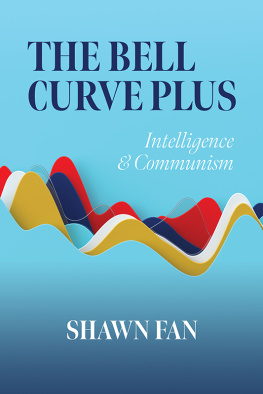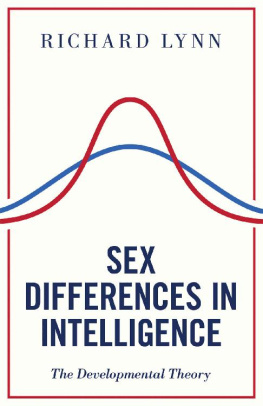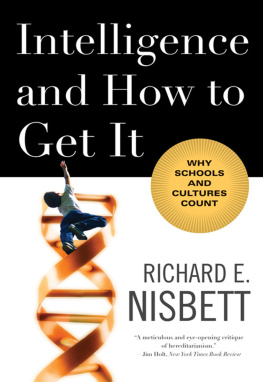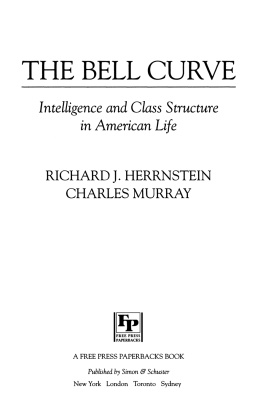THE BELL CURVE
Intelligence and Class Structure in American Life
RICHARD J. HERRNSTEIN
Simon & Schuster
The Bell Curve Phenomenon
The Bell Curves implications will be as profound for the beginning of the new century as Michael Harringtons discovery of the other America was for the final part of the old. Richard Herrnsteins bequest to us is a work of great value. Charles Murrays contribution goes on.
Chester E. Finn, Jr., Commentary
[The authors] have been cast as racists and elitists and The Bell Curve has been dismissed as pseudoscience. The books message cannot be dismissed so easily. Herrnstein and Murray have written one of the most provocative social science books published in many years. This is a superbly written and exceedingly well documented book.
Prof. Thomas J. Bouchard, Contemporary Psychology
The Bell Curve is a comprehensive treatment of its subject, never mean-spirited or gloating. It gives a fair hearing to those who dissent scientifically from its propositionsin fact, it bends over backward to be fair. Among the dozens of hostile articles that have thus far appeared, none has successfully refuted any of its science.
Christopher Caldwell, American Spectator
Mr. Murray and Mr. Herrnstein write that for the last 30 years, the concept of intelligence has been a pariah in the world of ideas, and that the time has come to rehabilitate rational discourse on the subject. It is hard to imagine a democratic society doing otherwise.
Malcolme W. Browne, The New York Times Book Review
Richard Herrnstein and Charles Murray might not feel at home with Daniel Patrick Moynihan and Lani Guinier, but they should. They have all [made] brave attempts to force a national debate on urgent matters that will not go away. And they have met the same fate. Once again, academia and the mass media are straining every muscle to suppress debate.
Prof. Eugene D. Genovese, National Review
The first reactions to The Bell Curve were expressions of public outrage. In the second round of reaction, some commentators suggested that Herrnstein and Murray were merely bringing up facts that were well known in the scientific community, but perhaps best not discussed in public. A Papua New Guinea language has a term for this, Mokita. It means truth that we all know, but agree not to talk about. There are fascinating questions here for those interested in the interactions between sociology, economics, anthropology and cognitive science. We do not have the answers yet. We may need them soon, for policy makers who rely on Mokita are flying blind.
Prof. Earl Hunt, American Scientist
From beginning to end, it is apparent that Herrnstein and Murray are eminently reasonable, responsible, civilized and compassionate human beings. Throughout their work opposing arguments and schools of thought are assiduously canvassed. Readers are alerted over and over again to contrary views and differing interpretations of the evidence presented. The expository chapters are written without jargon. The prose is exceptionally lucid, often elegant; far from being a boring, heavy-footed tome, the book is a good read from start to finish.
Prof. E. L. Patullo, Society
This is one of the most sober, responsible, thorough and thoughtful books to be published in years. I dont happen to agree with everything in it, but that is beside the point.
Thomas Sowell, author of Race and Culture: A World View

FREE PRESS PAPERBACKS
A Division of Simon & Schuster Inc.
1230 Avenue of the Americas
New York, N.Y. 10020
www.SimonandSchuster.com
Copyright 1994 by Richard J. Herrnstein and Charles Murray
All rights reserved, including the right of reproduction in whole or in part in any form.
First Free Press Paperback Edition 1996
FREE PRESS PAPERBACK and colophon are trademarks of Simon & Schuster Inc.
Manufactured in the United States of America
10 9 8 7 6
Library of Congress Cataloging-in-Publication Data
Herrnstein, Richard J.
The bell curve: intelligence and class structure in American life/ Richard J. Herrnstein and Charles Murray.1st Free Press paperback ed.
p. cm.(A Free Press paperbacks book)
Originally published: New York: Free Press, 1994.
Includes bibliographical references and index.
ISBN-13: 978-0-6848-2429-1
ISBN-10: 0-684-82429-9
eISBN-13: 978-1-4391-3491-7
1. Intellect. 2. Nature and nurture. 3. Intelligence levelsUnited States. 4. Intelligence levelsSocial aspectsUnited States. 5. Educational psychology. I. Murray, Charles A.
II. Title.
[BF431.H398 1996]
305.9082dc20 95-42934
CIP
Afterword copyright 1995 by Charles Murray, adapted from Commentary; used by permission. All rights reserved.
For JULIA, MAX, JAMES, NARISARA, SARAWAN, ANNA, AND BENNETT
We wrote with your world in our thoughts
There is a most absurd and audacious Method of reasoning avowed by some Bigots and Enthusiasts, and through Fear assented to by some wiser and better Men; it is this. They argue against a fair Discussion of popular Prejudices, because, say they, tho they would be found without any reasonable Support, yet the Discovery might be productive of the most dangerous Consequences. Absurd and blasphemous Notion! As if all Happiness was not connected with the Practice of Virtue, which necessarily depends upon the Knowledge of Truth.
EDMUND BURKE A Vindication of Natural Society
Contents
List of Illustrations
List of Tables
A Note to the Reader
We have designed The Bell Curve to be read at several levels.
At the simplest level, it is only about thirty pages long. Each chapter except the Introduction and the final two chapters opens with a precis of the main findings and conclusions minus any evidence for them, written in an informal style free of technical terms. You can get a good idea of what we have to say by reading just those introductory essays.
The next level is the main text. It is accessible to anyone who enjoys reading, for example, the science section of the news magazines. No special knowledge is assumed; everything you need to know to follow all of the discussion is contained within the book. The main text does include considerable technical material, however. The documentation becomes especially extensive when we come to a topic so controversial that many readers will have a This cant possibly be true reaction.
Sprinkled throughout the book are boxes that add more detail, discuss alternative ways of thinking about the data, or relate tidbits that dont quite fit in the text. You may skip any of these without interrupting the flow of the narrative, but we think they add something (or they wouldnt be there), and we encourage you to dip into them.
The endnotes provide the usual scholarly references. Some of them, indicated in text by endnote numbers enclosed in brackets, add short discussions that will be of interest mostly to specialists.
Finally, the appendixes elaborate on key issues. For example, readers who come to the book unfamiliar with statistics will find that Appendix 1 supplies the basics; if you want to know more about the debate over cultural bias in intelligence tests, Appendix 5 guides you through the literature on that issue; and so on. Other appendixes lay out the statistical detail that could not be fit into the main text and was too bulky for a note.








